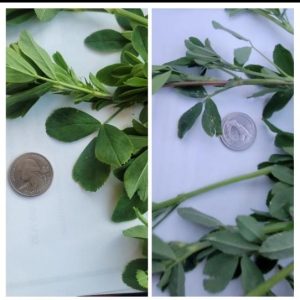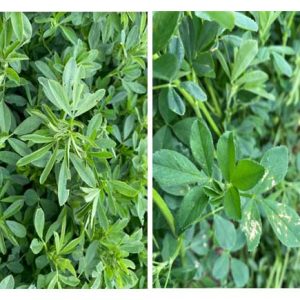Initial Challenges of Pilot Farm:
- Significant Reductions in Resources: Farm faced a water restriction of 40% this spring compared to spring of 2021. Water restrictions compounded by $100.00 fine for every acre foot used beyond 60% remaining water allotment. Due to a 400% increase in fertilizer this year, farmers paid double for fertilizer while reducing the amount of fertilizer in 2022 by 50% compared to the 2021 season.
- Climate Challenges: Spring weather was significantly colder and dryer this year, significantly impacting growth and development of crops. Farmer estimates that crops are at least 2 weeks behind historical records of growth.
- Leased Farm in Development: Farmer is in 4th year of lease with this farm. Soil is poor in comparison to the region and the irrigation system was significantly depleted and damaged before assuming current farm operations.
2022 H2Organix Pilot Results
Upon using 12 ounces of H2Organix per acre…
- 63% Average Water Reduction: In response to new water restrictions, water was reduced differently by field and crop variety (anywhere between 28% and 84%) resulting in an average water reduction of 63.24%. Fields with no water restrictions had lower yields than fields with water restrictions.
No water restrictions= ~1.8 to 1.9 tons per acre
Water restrictions= ~2.1 to 2.4 tons per acre. - Crop Development Time Savings: Despite climate challenges, crops were harvested close to historical first harvest dates, a crop development savings of roughly 10-12 days. Recapture in crop development will be crucial for 3rd cutting success if fall comes early.
- Significant Improvement in Crop Value: Timothy hay was sold last year at $260.00 per ton. Due to increased quality, timothy hay in the first cutting was valued at $400.00 per ton, an increase of 53.8%. Relative Feed Value (RFV) and Protein levels “tested out” meaning that they were the highest quality for crops in the region. Crop quality has never been so high.
- Less Pests, Healthier Lady Bugs and Pollinating Bees: in the 20 fields of 2,500 acres, only two fields reported mild pest damage. The remaining fields had no sign of pest damage, increased ladybug presence, and improved beehive health. Beehive health was performing 2 months ahead of schedule in honey production and overall hive development.
Bactelife Pilot Research
How does water conservation impact crop yield and health?
In 2020, Utah State University conducted a study that showed the impact of reducing water by 25% and 50% respectively. “When irrigation was reduced by 25%, alfalfa yield was reduced by an average of about .75 tons per acre (20%) total for the two cuts. A 50% reduction in irrigation procured an average of 30% less yield (1.15 tons per acre). Results were mixed for the 50% targeted irrigation. It was much worse than the straight 50% reduction for the first cutting but much better in the second cutting.”
Source: https://hayandforage.com/article-3404-turning-down-the-irrigation-spigot.html
Crucial Findings for Future Development
When contrasted with USU research, Bactelife is proving to be a sustainability tool for farmers that are restricted by fertilizer and water shortages.
- Yields higher than anticipated with 77.26%% less water
- Crop value and quality are significantly higher than expected with 50% less fertilizer.
- Nutrient Value of crops are superior with 50% less fertilizer.
H2Organix Data Review
Relative Feed Value (RFV)= 184.43
Crop: Roundup Ready Alfalfa
Total Acres: 171 acres
2021 First Cutting: ~2.16 Tons per acre
2022 First Cutting: ~2.4 Tons per acre
2021 Average kWh per Day 1,061.3
2022 Average kWh per Day 241.3
2022 Water Reduction: 77.26%
Estimated Crop Impact: 11% increase in tonnage
| First Cutting Crop Analysis: Independent Review | |||
|---|---|---|---|
| Area | Field 18 | Regional Median | 90% Range |
| Protein Sol. | 47.63 | 37.11 | 27.47-47.14 |
| Calcium | 1.83 | 1.54 | 1.19-1.84 |
| Phosphorus | .35 | .31 | .23-.39 |
| Sulfur | .31 | .25 | .17-.33 |
| Sugar (ESC) | 9.3 | 6.03 | 2.71-9.16 |
| Sugar (WSC) | 10.7 | 7.14 | 3.32-10.19 |
Farmer Response to Pilot
- Second Application: Farmer was highly satisfied with the impact. Decided to do a second application for second cutting.
- Farm Expansion: Farmer decided to expand to a second location because of first cutting success.
- Nano-tech Trial: Famer experimenting with new fertilizer that does not emit greenhouse gasses (GHG). Farmer intends to expand positive environmental and soil health practices.
Farmer perspective:
I am really happy with what your ‘bugs’ are doing to my crops. I am going to expand this into my Aberdeen fields after the first cutting. When I walk through my Taber farm and taste my alfalfa, it tastes so much different, and I can’t see any pests anywhere. Every day I see something different, and it is good. It has been good to hear improvements from others that help me with my farm. My beekeeper and hay buyer noticed the difference as well. I have never farmed with a water restriction warning. I have never turned off the pivots, so reducing water is a big deal for me. This season started off so cold and dry that all of my neighbor farms are concerned that they might not get their first cutting until the end of June or first part of July. My field is doing so well that it looks like I will be able to cut on the 14th of June, a full two weeks ahead of other farmers in my region. I have always wanted to find a way to reduce costs and conserve” water and resources. This was a good choice that turned out well for me and my farm and I’m glad I decided to give it a try!

Quality You Can See
Treated fields had healthier leaves, richer color, sweeter taste. Independent testing confirmed superior nutrient quality and value.

Improved Plant Health
Untreated fields with more water showed higher levels of pest damage and disease. Untreated fields had lower yields and a noticeable decrease in insects that naturally keep damaging insects in check.

Less Pests, More Biological Support
Untreated fields with more water showed higher levels of pest damage and disease. Untreated fields had lower yields and a noticeable decrease in insects that naturally keep damaging insects in check.

